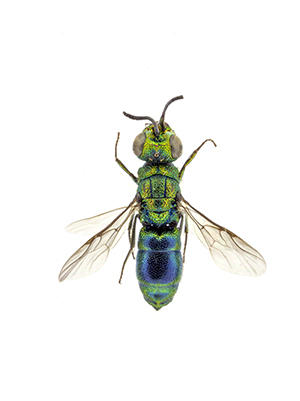Last updated on November 28th, 2023
 From: Kimsey L.S. & Bohart R.M., 1990 (1991) – The chrysidid wasps of the world. Oxford University Press, ix-652 pp.
From: Kimsey L.S. & Bohart R.M., 1990 (1991) – The chrysidid wasps of the world. Oxford University Press, ix-652 pp.
Synonymy
Trichrysis Lichtenstein 1876:27. Type: Chrysis cyanea Linnaeus 1758:572. Monobasic.
Alocochrysis Haupt 1956:83. Type: Chrysis cyanea Linnaeus 1758:572. Monobasic.
Generic diagnosis
Face nearly always transversely ridged-punctate, scapal basin moderately concave; TFC often a medial and inverted obtuse V, sometimes nearly complete, sometimes absent, sometimes above a sharp and nearly cariniform brow; F-I usually 2.0-2.5 MOD, at least as long as F-II or pedicel, extreme lengths 1.2 MOD (male) and 3.8 MOD (female); malar space usually 1-2 MOD, longer than subantennal space (one species 3.5 MOD); mid ocellar area rarely defined; mid ocellus not lidded; subgenal area sometimes partly defined; pronotum shorter than scutellum, lateral depression deep; fore wing Rs long, nearly complete, marginal cell ending acutely, discoidal cell sometimes faint outwardly; metanotum simple; mesopleuron with scrobal sulcus which may be areolate, omaulus absent above scrobal sulcus; propodeal angle incurved posteriorly to nearly straight; T-II sometimes highly coloured, apicolateral angle nearly 90°, medial carina weak; T-III with three apical teeth or denticles, intervening edge may be lobulate; S-II spots small, double, or fused; female T-V-VI simple. Male terminalia: S-VIII subtriangular, gonocoxa usually stout near apex, rarely ligulate apically, cuspis broadly rounded.
Hosts
A variety of hosts have been recorded for cyanea. As listed by Trautmann (1927): Trypoxylnon, Nitela, and Cemonus in the Sphecidae, Ancistrocerus in the Eumenidae, and Chelostoma, Osmia, and Heriades in the Megachilidae.
Distribution
Trichrysis is well represented in the Afrotropical (seven species), Palearctic (eleven species) and Oriental Regions (seven species).
Discussion
Trichrysis has frequently been confused with other genera, some of whose species may have a tridentate T-III. This confusion especially concerns the New World genus Caenochrysis. Linsenmaier (1984) described 32 new species from South America in Trichrysis and one of these (rossi) with mistaken locality is an Asian form. Trichrysis differs in several respects from Caenochrysis. The sublateral facial pits of the latter are an immediate separation point. In addition, Trichrysis always has three denticles or teeth on T-III although the middle one may be tiny in males, S-II spots are medial, and the metanotum is simple. All of these last features are variable in Caenochrysis. Other genera with one or more tridentate species are Allochrysis, Chrysidea, Odontochrydium, and Primeuchroeus, differences from Trichrysis are discussed under those genera. Of the 26 listed species, we have been able to study types or other authenticated specimens of 23. We are not familiar with coreana, purpuripyga, or sudai, and some additional synonymy may be in order. The genus exhibits considerable morphological diversity, especially in the pronotal shape, but the differences between species are rather gradual and do not lend themselves to the formation of species groups. Most species have the pronotum markedly concave laterally in dorsal view, and with a continuous sublateral carina; examples are cyanea, triacantha, and buyssoni. A few species, such as trigona, eardleyi, and hexapholis have the concavity but the carina is broken medially. Other species with a slight concavity and no carina are polinierii, heliophila, and impressifrons. In some species, such as buyssoni, there may be a sharp medial pronotal groove, but in others, as in impressifrons, hardly any groove. TFC is most often a small, obtuse inverted V. In buyssoni, eardleyi, and excisifrons TFC is continued almost to the ocular margin. In vestigator it has backward branches which delimit a mid ocellar area. In many species the brow is quite sharp and looks like a second TFC a little below the first. TFC is absent in bohemanni and obsolescent in heliophila. The only two species we have seen with a long malar space (3.5 MOD) are lomboldti and impressifrons. Most species have the fore wing discoidal cell complete even though the outer veins may be narrow. However, in bohemanni both outer veins are quite faint. The shape of the apical teeth on T-III is an important taxonomic character. In cyanea the medial one is a denticle and the outer ones simply angles. In bohemanni all three are denticles. At the other extreme, as in hexapholis, the teeth are long and sharp. Bohart (1988) gave a key to species, and described several new ones.
European species
Copyright, Authorship, and Ownership statements
All text and images of this page are copyright ©️ Chrysis.net unless otherwise stated - please see individual cases for authorship and copyright details. The specimens pictured are from the authors' or other collaborators' personal collections and from the collections of various museums. Unless otherwise specified, the whole content of this web site is for personal, non-commercial, scientific, and educational purposes given proper accreditation to the page from which they were derived are provided, and under Chrysis.net Terms and Conditions.
For citation purposes
Agnoli G.L. & Rosa P. (2024) Genus Trichrysis Lichtenstein, 1876, in: Chrysis.net website. Interim version 19 April 2024, URL: https://www.chrysis.net/database/genus-trichrysis/.




